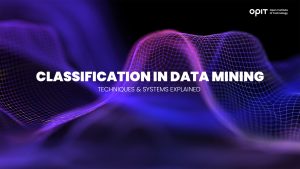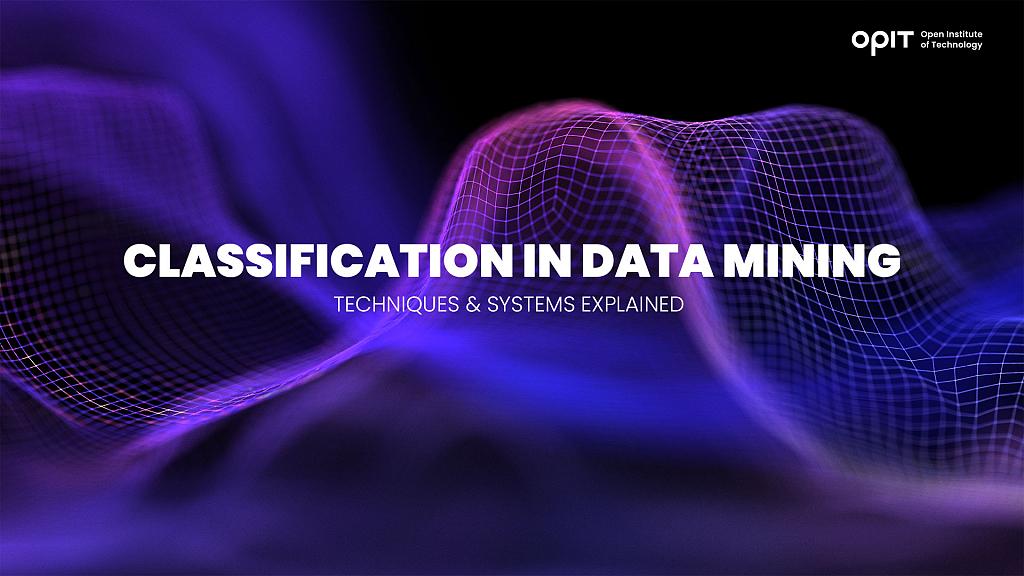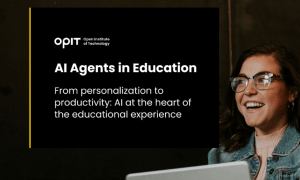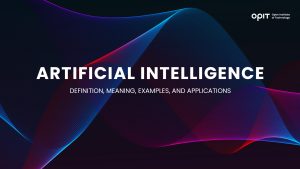

Data mining is an essential process for many businesses, including McDonald’s and Amazon. It involves analyzing huge chunks of unprocessed information to discover valuable insights. It’s no surprise large organizations rely on data mining, considering it helps them optimize customer service, reduce costs, and streamline their supply chain management.
Although it sounds simple, data mining is comprised of numerous procedures that help professionals extract useful information, one of which is classification. The role of this process is critical, as it allows data specialists to organize information for easier analysis.
This article will explore the importance of classification in greater detail. We’ll explain classification in data mining and the most common techniques.
Classification in Data Mining
Answering your question, “What is classification in data mining?” isn’t easy. To help you gain a better understanding of this term, we’ll cover the definition, purpose, and applications of classification in different industries.
Definition of Classification
Classification is the process of grouping related bits of information in a particular data set. Whether you’re dealing with a small or large set, you can utilize classification to organize the information more easily.
Purpose of Classification in Data Mining
Defining the classification of data mining systems is important, but why exactly do professionals use this method? The reason is simple – classification “declutters” a data set. It makes specific information easier to locate.
In this respect, think of classification as tidying up your bedroom. By organizing your clothes, shoes, electronics, and other items, you don’t have to waste time scouring the entire place to find them. They’re neatly organized and retrievable within seconds.
Applications of Classification in Various Industries
Here are some of the most common applications of data classification to help further demystify this process:
- Healthcare – Doctors can use data classification for numerous reasons. For example, they can group certain indicators of a disease for improved diagnostics. Likewise, classification comes in handy when grouping patients by age, condition, and other key factors.
- Finance – Data classification is essential for financial institutions. Banks can group information about consumers to find lenders more easily. Furthermore, data classification is crucial for elevating security.
- E-commerce – A key feature of online shopping platforms is recommending your next buy. They do so with the help of data classification. A system can analyze your previous decisions and group the related information to enhance recommendations.
- Weather forecast – Several considerations come into play during a weather forecast, including temperatures and humidity. Specialists can use a data mining platform to classify these considerations.
Techniques for Classification in Data Mining
Even though all data classification has a common goal (making information easily retrievable), there are different ways to accomplish it. In other words, you can incorporate an array of classification techniques in data mining.
Decision Trees
The decision tree method might be the most widely used classification technique. It’s a relatively simple yet effective method.
Overview of Decision Trees
Decision trees are like, well, trees, branching out in different directions. In the case of data mining, these trees have two branches: true and false. This method tells you whether a feature is true or false, allowing you to organize virtually any information.
Advantages and Disadvantages
Advantages:
- Preparing information in decision trees is simple.
- No normalization or scaling is involved.
- It’s easy to explain to non-technical staff.
Disadvantages:
- Even the tiniest of changes can transform the entire structure.
- Training decision tree-based models can be time-consuming.
- It can’t predict continuous values.
Support Vector Machines (SVM)
Another popular classification involves the use of support vector machines.
Overview of SVM
SVMs are algorithms that divide a dataset into two groups. It does so while ensuring there’s maximum distance from the margins of both groups. Once the algorithm categorizes information, it provides a clear boundary between the two groups.
Advantages and Disadvantages
Advantages:
- It requires minimal space.
- The process consumes little memory.
Disadvantages:
- It may not work well in large data sets.
- If the dataset has more features than training data samples, the algorithm might not be very accurate.
Naïve Bayes Classifier
The Naïve Bayes is also a viable option for classifying information.
Overview of Naïve Bayes Classifier
The Naïve Bayes method is a robust classification solution that makes predictions based on historical information. It tells you the likelihood of an event after analyzing how many times a similar (or the same) event has taken place. The most frequent application of this algorithm is distinguishing non-spam emails from billions of spam messages.
Advantages and Disadvantages
Advantages:
- It’s a fast, time-saving algorithm.
- Minimal training data is needed.
- It’s perfect for problems with multiple classes.
Disadvantages:
- Smoothing techniques are often required to fix noise.
- Estimates can be inaccurate.
K-Nearest Neighbors (KNN)
Although algorithms used for classification in data mining are complex, some have a simple premise. KNN is one of those algorithms.
Overview of KNN
Like many other algorithms, KNN starts with training data. From there, it determines the distance between particular objects. Items that are close to each other are considered related, which means that this system uses proximity to classify data.
Advantages and Disadvantages
Advantages:
- The implementation is simple.
- You can add new information whenever necessary without affecting the original data.
Disadvantages:
- The system can be computationally intensive, especially with large data sets.
- Calculating distances in large data sets is also expensive.
Artificial Neural Networks (ANN)
You might be wondering, “Is there a data classification technique that works like our brain?” Artificial neural networks may be the best example of such methods.
Overview of ANN
ANNs are like your brain. Just like the brain has connected neurons, ANNs have artificial neurons known as nodes that are linked to each other. Classification methods relying on this technique use the nodes to determine the category to which an object belongs.
Advantages and Disadvantages
Advantages:
- It can be perfect for generalization in natural language processing and image recognition since they can recognize patterns.
- The system works great for large data sets, as they render large chunks of information rapidly.
Disadvantages:
- It needs lots of training information and is expensive.
- The system can potentially identify non-existent patterns, which can make it inaccurate.
Comparison of Classification Techniques
It’s difficult to weigh up data classification techniques because there are significant differences. That’s not to say analyzing these models is like comparing apples to oranges. There are ways to determine which techniques outperform others when classifying particular information:
- ANNs generally work better than SVMs for making predictions.
- Decision trees are harder to design than some other, more complex solutions, such as ANNs.
- KNNs are typically more accurate than Naïve Bayes, which is rife with imprecise estimates.
Systems for Classification in Data Mining
Classifying information manually would be time-consuming. Thankfully, there are robust systems to help automate different classification techniques in data mining.
Overview of Data Mining Systems
Data mining systems are platforms that utilize various methods of classification in data mining to categorize data. These tools are highly convenient, as they speed up the classification process and have a multitude of applications across industries.
Popular Data Mining Systems for Classification
Like any other technology, classification of data mining systems becomes easier if you use top-rated tools:
WEKA
How often do you need to add algorithms from your Java environment to classify a data set? If you do it regularly, you should use a tool specifically designed for this task – WEKA. It’s a collection of algorithms that performs a host of data mining projects. You can apply the algorithms to your own code or directly into the platform.
RapidMiner
If speed is a priority, consider integrating RapidMiner into your environment. It produces highly accurate predictions in double-quick time using deep learning and other advanced techniques in its Java-based architecture.
Orange
Open-source platforms are popular, and it’s easy to see why when you consider Orange. It’s an open-source program with powerful classification and visualization tools.
KNIME
KNIME is another open-source tool you can consider. It can help you classify data by revealing hidden patterns in large amounts of information.
Apache Mahout
Apache Mahout allows you to create algorithms of your own. Each algorithm developed is scalable, enabling you to transfer your classification techniques to higher levels.
Factors to Consider When Choosing a Data Mining System
Choosing a data mining system is like buying a car. You need to ensure the product has particular features to make an informed decision:
- Data classification techniques
- Visualization tools
- Scalability
- Potential issues
- Data types
The Future of Classification in Data Mining
No data mining discussion would be complete without looking at future applications.
Emerging Trends in Classification Techniques
Here are the most important data classification facts to keep in mind for the foreseeable future:
- The amount of data should rise to 175 billion terabytes by 2025.
- Some governments may lift certain restrictions on data sharing.
- Data automation is expected to be further automated.
Integration of Classification With Other Data Mining Tasks
Classification is already an essential task. Future platforms may combine it with clustering, regression, sequential patterns, and other techniques to optimize the process. More specifically, experts may use classification to better organize data for subsequent data mining efforts.
The Role of Artificial Intelligence and Machine Learning in Classification
Nearly 20% of analysts predict machine learning and artificial intelligence will spearhead the development of classification strategies. Hence, mastering these two technologies may become essential.
Data Knowledge Declassified
Various methods for data classification in data mining, like decision trees and ANNs, are a must-have in today’s tech-driven world. They help healthcare professionals, banks, and other industry experts organize information more easily and make predictions.
To explore this data mining topic in greater detail, consider taking a course at an accredited institution. You’ll learn the ins and outs of data classification as well as expand your career options.
Related posts

Source:
- Times of Malta, published on September 18th, 2025
4 min read
The gathering brought together academics and technology leaders from prominent European Institutions, such as Instituto de Empresa (IE University), OPIT itself and the Royal College of Arts, to explore how artificial intelligence is reshaping the university experience.
The OPIT AI Copilot has been trained on the institute’s complete academic archive, a collection created over the past three years that includes 131 courses, more than 3,500 hours of recorded lectures, 7,500 study resources, 320 certified assessments, and thousands of exercises and original learning documents.
Unlike generic AI tools, the Copilot is deeply integrated with OPIT’s learning management system, allowing it to track each student’s progress and provide tailored support.
This integration means the assistant can reference relevant sources within the learning environment, adapt to the student’s stage of study, and ensure that unreleased course content remains inaccessible.
A mobile app is also scheduled for release this autumn, that will allow students to download exercise and access other tools.
During examinations, the Copilot automatically switches to what the institute calls an “anti-cheating mode”, restricting itself to general research support rather than providing direct answers.
For OPIT’s international community of 500 students from nearly 100 countries, many of whom balance studies with full-time work, the ability to access personalised assistance at any time of day is a key advantage.
“Eighty-five per cent of students are already using large language models in some way to study,” said OPIT founder and director Riccardo Ocleppo. “We wanted to go further by creating a solution tailored to our own community, reflecting the real experiences of remote learners and working professionals.”
Tool aims to cut correction time by 30%
The Copilot will also reduce administrative burdens for faculty. It can help grade assignments, generate new educational materials, and create rubrics that allow teachers to cut correction time by as much as 30 per cent.
According to OPIT, this will free up staff to dedicate more time to teaching and direct student engagement.
At the Milan event, Rector Francesco Profumo underlined the broader implications of AI in higher education. “We are in the midst of a deep transformation, where AI is no longer just a tool: it is an environment that radically changes how we learn, teach, and create,” he said.
“But it is not a shortcut. It is a cultural, ethical, and pedagogical challenge, and to meet it we must have the courage to rethink traditional models and build bridges between human and artificial intelligence.”
OPIT was joined on stage by representatives from other leading institutions, including Danielle Barrios O’Neill of the Royal College of Art, who spoke about the role of AI in art and creativity, and Francisco Machin of IE University, who discussed applications in business and management education.
OPIT student Asya Mantovani, also employed at a leading technology and consulting firm in Italy, gave a first-hand account of balancing professional life with online study.
The assistant has been in development for the past eight months, involving a team of OPIT professors, researchers, and engineers.
Ocleppo stressed that OPIT intends to make its AI innovations available beyond its own institution. “We want to put technology at the service of higher education,” he said.
“Our goal is to develop solutions not only for our own students, but also to share with global institutions eager to innovate the learning experience in a future that is approaching very quickly.”

From personalization to productivity: AI at the heart of the educational experience.
Click this link to read and download the e-book.
At its core, teaching is a simple endeavour. The experienced and learned pass on their knowledge and wisdom to new generations. Nothing has changed in that regard. What has changed is how new technologies emerge to facilitate that passing on of knowledge. The printing press, computers, the internet – all have transformed how educators teach and how students learn.
Artificial intelligence (AI) is the next game-changer in the educational space.
Specifically, AI agents have emerged as tools that utilize all of AI’s core strengths, such as data gathering and analysis, pattern identification, and information condensing. Those strengths have been refined, first into simple chatbots capable of providing answers, and now into agents capable of adapting how they learn and adjusting to the environment in which they’re placed. This adaptability, in particular, makes AI agents vital in the educational realm.
The reasons why are simple. AI agents can collect, analyse, and condense massive amounts of educational material across multiple subject areas. More importantly, they can deliver that information to students while observing how the students engage with the material presented. Those observations open the door for tweaks. An AI agent learns alongside their student. Only, the agent’s learning focuses on how it can adapt its delivery to account for a student’s strengths, weaknesses, interests, and existing knowledge.
Think of an AI agent like having a tutor – one who eschews set lesson plans in favour of an adaptive approach designed and tweaked constantly for each specific student.
In this eBook, the Open Institute of Technology (OPIT) will take you on a journey through the world of AI agents as they pertain to education. You will learn what these agents are, how they work, and what they’re capable of achieving in the educational sector. We also explore best practices and key approaches, focusing on how educators can use AI agents to the benefit of their students. Finally, we will discuss other AI tools that both complement and enhance an AI agent’s capabilities, ensuring you deliver the best possible educational experience to your students.
Have questions?
Visit our FAQ page or get in touch with us!
Write us at +39 335 576 0263
Get in touch at hello@opit.com
Talk to one of our Study Advisors
We are international
We can speak in:

